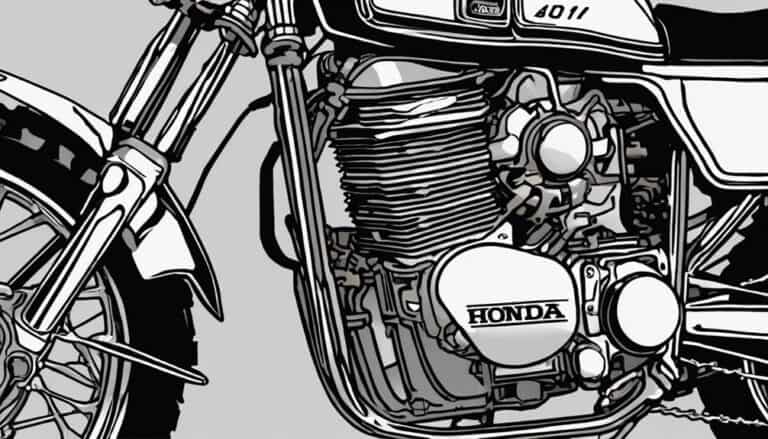If you're wondering why your 1990 Honda XR100 dirt bike is ticking, the rhythmic sound echoing from its depths might be a sign of an underlying issue that demands your attention.
Amidst the hum of the engine, that persistent tick could be hinting at a mechanical anomaly waiting to be uncovered.
Before you jump to conclusions or rush to seek a solution, take a moment to understand the potential causes behind this audial irregularity.
From valve clearances to cam chain tensions, your dirt bike's ticking tale might hold the key to a smoother ride ahead.
Key Takeaways
- Check valve clearance and cam chain tension for ticking noise.
- Maintain proper lubrication and inspect camshaft components.
- Monitor spark plug condition for engine health insights.
- Address exhaust system concerns to prevent ticking issues.
Possible Causes of Ticking Noise
If you hear a ticking noise in your 1990 Honda XR100 dirt bike, it may be caused by issues such as tight valve clearance or improper cam chain tension. These problems can lead to the components in the top end of the engine not functioning as they should, resulting in the distinctive ticking sound.
Insufficient lubrication can also contribute to this noise, emphasizing the importance of regular maintenance to keep the engine running smoothly.
Worn out camshaft lobes or valve lifters are additional culprits that could create ticking noises while the engine is in operation. Loose or damaged components in the top end of the engine can further exacerbate the ticking noise in your XR100.
To address these issues, it's essential to conduct proper maintenance routines, including checking and adjusting the valve clearance and ensuring the cam chain tension is within the specified limits. By staying on top of these maintenance tasks, you can prevent ticking noises and keep your Honda XR100 performing at its best.
Checking Valve Clearance
To guarantee peak engine performance and prevent ticking noises in your 1990 Honda XR100 dirt bike, start by checking the valve clearance by measuring the gap between the top of the valve and the rocker arm. Proper valve clearance is essential for the valves to open and close at the correct time during the engine's operation. Incorrect valve clearance can result in poor engine performance, overheating, or even damage to engine components.
Follow these steps for checking valve clearance effectively:
- Refer to the manufacturer's specifications for the proper valve clearance measurements.
- Use feeler gauges to accurately measure the gap between the valve and the rocker arm.
- Adjust the valve clearance if necessary to ensure it falls within the specified range.
- Reinstall the spark plug and other components correctly after completing the valve adjustment.
Regularly checking and maintaining the valve clearance of your Honda XR100 dirt bike is essential for optimal engine function and overall performance.
Inspecting Cam Chain Tension
Inspecting cam chain tension is a critical maintenance task that directly impacts the peak performance and longevity of your Honda XR100 dirt bike's engine. Proper cam chain tension is essential for ideal engine performance and reducing noise.
When inspecting the cam chain, check for any signs of looseness or slack that could lead to ticking noises. Adjusting cam chain tension is vital and requires using the correct tools and following the manufacturer's guidelines for your specific model.
A well-tensioned cam chain guarantees accurate timing of engine components, resulting in smoother operation and decreased wear over time. Regularly checking and adjusting the cam chain tension can help prevent potential damage to the engine and extend the life of your dirt bike.
Evaluating Spark Plug Condition
When evaluating the spark plug condition on your 1990 Honda XR100 dirt bike, pay close attention to the color of the spark plug. The spark plug color can provide valuable insights into the engine's performance and health. Here are some key points to bear in mind:
- Inspect Spark Plug Color: A white or light gray spark plug indicates a lean fuel mixture, while a black or sooty plug suggests a rich mixture.
- Check for Oil Fouling: Presence of oil fouling on the spark plug may indicate oil burning in the combustion chamber.
- Engine Health Indicator: The spark plug condition serves as an indicator of the engine's overall health and performance.
- Early Issue Detection: Regularly monitoring and interpreting the spark plug condition can help diagnose potential issues such as valve problems, oil burning, or combustion chamber issues early on.
Addressing Exhaust Leak
How can you effectively identify and resolve an exhaust leak causing a ticking noise in your 1990 Honda XR100 dirt bike?
To address the ticking noise, start by inspecting the exhaust system thoroughly. Look for any signs of leaks, cracks, or loose connections that could be causing the issue. Pay close attention to areas where different components of the exhaust system come together, as these junctions are common places for leaks to occur.
Once you have identified the source of the leak, take the necessary steps to secure it. Depending on the severity of the leak, you may be able to use exhaust tape or sealant to patch it up. In cases where the damage is more extensive, you may need to replace the damaged component entirely. Make sure to follow the manufacturer's guidelines for sealing or replacing the exhaust components to secure proper functioning and to eliminate the ticking noise.
Conclusion
So, your 1990 Honda XR100 dirt bike is ticking, huh? Well, it's time to roll up your sleeves and get down to business.
Remember, proper maintenance is key to keeping your ride in top shape. Don't let that ticking noise get you down – with a little elbow grease and some troubleshooting, you'll have your dirt bike purring like a kitten in no time.
Ride on!

